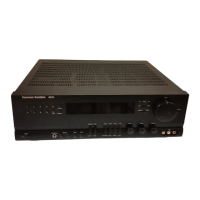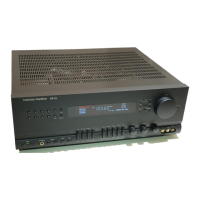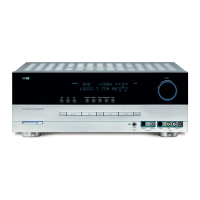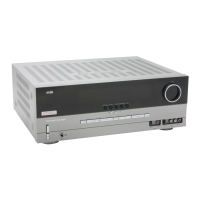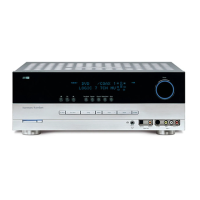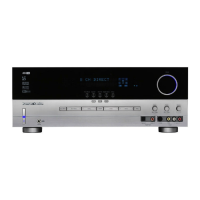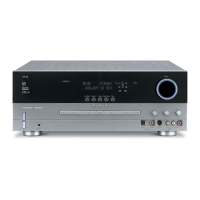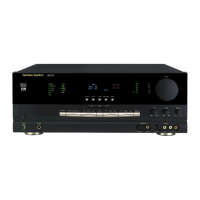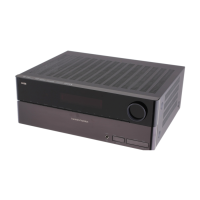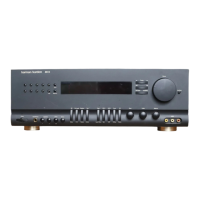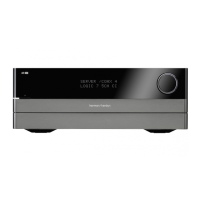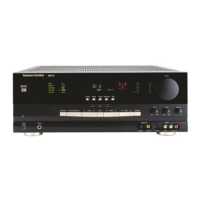
Do you have a question about the Harman Kardon AVR 210 and is the answer not in the manual?
| Channels | 5.1 |
|---|---|
| Total Harmonic Distortion | 0.07% |
| Input Sensitivity | 200mV |
| Speaker Load Impedance | 8 ohms |
| Digital Inputs | 2 Optical, 1 Coaxial |
| Video Connections | Composite, S-Video |
| Frequency Response | 10Hz to 100kHz |
| Signal to Noise Ratio | 95dB |
| Dimensions | 440 x 165 x 385mm |
| Power Output | 50 watts per channel into 8Ω (stereo) |
Details the versatility and features of the AVR 210, including surround modes and advanced audio processing.
Key safety precautions for power, installation, cleaning, and moving the unit.
Information on FCC compliance, RF energy, and handling radio frequency interference.
Controls for power, volume, tone, balance, and headphone jack usage.
Input Source Selector, FM Mode, and Digital Input selectors for source selection.
Surround Mode Selector, Tuner controls, and FM Mode Selector for audio and tuning.
Buttons for system setup: Speaker Select, Test Tone, Delay, and Digital Input.
Bitstream indicators for Dolby Digital, DTS, PCM, and MP3 signal types.
Indicators for selected input sources and surround modes (Optical, Logic 7).
Speaker/Channel Input Indicators for speaker type and signal configuration.
Main Information Display, Mute, Memory, Stereo, Tuned, and Auto indicators.
Jacks for connecting tape decks, audio sources, and recorders.
Connections for video sources, digital audio (Optical/Coaxial), and video monitor out.
Connections for antennas, AC power, accessory outlets, and remote control systems.
Connecting external decoders and power amplifiers for expanded audio capabilities.
Input Selectors, AVR Selector, Power On/Off buttons for system control.
Surround Mode, Night Mode, Digital Select, and Tuner controls.
Channel Select, Test Button, Set Button, OSD Button, and Speaker Select.
Macro programming, Volume Punch-Through, and EzSet functions.
Placing the unit, connecting audio sources, recorders, and speakers.
Connecting VCRs, DVD players, satellite receivers, and video monitors.
Connecting antennas, AC power, accessory outlets, and remote control systems.
Connecting external decoders and power amplifiers for expanded audio capabilities.
Guidelines for selecting, placing, and optimizing speaker positions.
Configuring input assignments, surround modes, and delay times.
Detailed settings for speaker types, subwoofer presence, and channel assignments.
Calibrating speaker output levels using EzSet or manual methods.
Turning the unit on/off, adjusting volume, and selecting audio/video sources.
Choosing and using various surround sound modes and understanding the chart.
Understanding digital signals, indicators, and Night Mode operation.
Tuning stations, storing presets, and MP3 audio playback.
Adjusting display brightness and setting the turn-on volume level.
Configuring semi-OSD messages and full-OSD time-out settings.
Using Direct Code Entry and Auto Search to program the remote.
Creating macros, operating programmed devices, and punch-through functions.
Customizing input selectors and restoring remote to factory defaults.
Mapping remote buttons to specific functions for various devices.
Setup codes for programming the remote to control TVs, VCRs, and CD players.
Setup codes for programming the remote to control DVD players, SAT receivers, and Cable boxes.
Addresses issues like no power, no sound, display problems, and remote response.
Steps to reset the system memory and microprocessor to clear malfunctions.
Details on power output, surround modes, frequency response, and tuner performance.
Specifications for video response, power requirements, dimensions, and weight.
